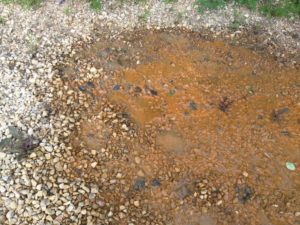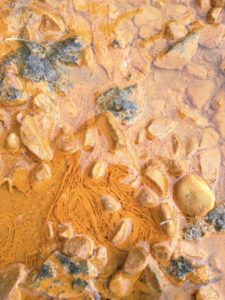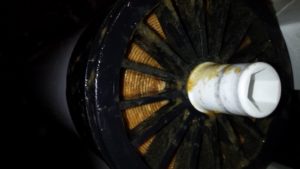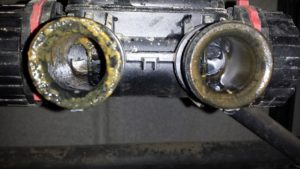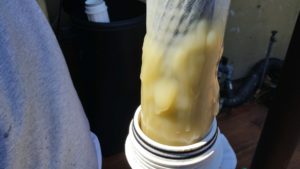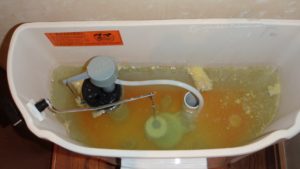Our planet is teeming with life. Algae, mold, bacteria and other organisms are commonly found in surface water, and play a vital role in the cycle of life. An entire sphere of our industry’s expertise is devoted to cleaning surface water sources and making them fit for human consumption. Conventional logic asserts that surface water contains far more contaminants than groundwater; and this can certainly be the case since groundwater has typically percolated or filtered through non-permeable material that acts as a filter and clarifier. In fact, for many years, the water industry has considered groundwater to be generally safe from bacterial contamination.

Bacteria are some of the most ancient organisms known to exist on our planet and many extremophilic strains can survive in extreme conditions of chemistry, temperature and pressure. Bacteria can even survive dehydration, be carried by wind or water and lay dormant for years before being reactivated under the right conditions to sustain their lifecycle. Aerobic bacteria thrive in oxygen rich environment and those that thrive without it are known as anaerobic bacteria. Bacteria are prokaryotic organisms that reproduce asexually. Bacterial reproduction most commonly occurs by a form of cellular division called binary fission, which results in the formation of two bacterial cells that are genetically identical. As the first living step in the food chain, bacteria are phenomenal energy transformers; they live by interacting with their environment and utilizing various metals, minerals and organics as food. They then excrete their metabolic byproducts which can take a number of forms, including enzymes, gases, acids and chemical compounds.
Bacteria are not all necessarily bad; we use beneficial bacteria to produce salami, yogurt, cheese, sauerkraut, beer, wine and other fine foods as well as manufacturing vitamin products, sweeteners, construction materials and a host of other modern conveniences. Our bodies also rely on beneficial bacteria to live and function properly. Without bacteria, we would simply cease to exist. There is a significant amount of research into beneficial bacteria that can be used for wastewater treatment, bioremediation and even water purification for drinking. Until we fully understand the benefits and risks of non-pathogenic bacteria and other microorganisms in water, the most sensible approach is to prevent all microorganisms from growing in the plumbing systems that we are tasked with protecting.
Bacteria exist in all healthy soils, so it is no surprise that even groundwater from the deepest wells can contain bacteria and other living organisms. As testing and technology improves, we are finding more and more living organisms in places that we never expected to find them. Recent sampling in South Africa’s Mponeng mine found waterborne bacteria (Desulfotomaculum) more than two miles below ground within rock strata, living happily on sulfates and hydrogen gas, while metabolizing hydrogen sulfide (H2S) into the water with the aid of ambient uranium radioactivity. This is not an isolated case, but thankfully, deep water bacteria found in strata and aquifers will usually fit into the category of nuisance bacteria and are not expected to be directly pathogenic.

An estimated 130 million Americans drink, bathe and work with ground-sourced water every day, much of it from municipal and community supply systems that are supervised by professionals to ensure it meets the minimum quality standards specified by US EPA. About five million privately owned wells serve another estimated 40 million users who don’t have access to the same daily professional oversight.
US EPA’s regulatory guidelines for drinking water are carefully designed to maximize protection of human health, while also minimizing the cost and effort of delivering water. These legally enforceable guidelines address microorganisms, disinfectants, DBPs, inorganic and organic chemicals and radionuclides. This minimum water quality standard is a good start and can be certainly credited with helping Americans live longer and better lives than ever before.
Of the regulated microorganisms, the listed offenders are:
| Cryptosporidium | Single-celled protozoan parasite commonly found in surface waters, especially when the water is contaminated with sewage and animal waste. Can cause gastrointestinal illness. |
| Giardia lamblia | Single-celled protozoan parasite that lives in the intestine of infected humans or animals. It can be found on surfaces, in soil, food, or water that has been contaminated with the feces from infected humans or animals. Can cause symptoms such as nausea, cramps, diarrhea and associated headaches. |
| Legionella | These gram-negative bacteria can be found in groundwater and thrive in warm environments like hot tubs, cooling towers, hot water tanks, humidifiers, open-loop radiant-heating systems, large plumbing systems, or parts of the air-conditioning systems of large buildings. Legionella bacteria pose a significant health risk when aerosolized (in an air conditioning system, humidifier, eyewash station, or a shower) and then inhaled. Inhalation often results in a type of pneumonia known as Legionnaires disease.
|
| Viruses (enteric) | Enteroviruses are a genus of single-stranded RNA viruses that live in the intestines of mammals and includes the polio, coxsackie, echo and other enterovirus groups. As of this writing, the scientific community has identified 62 known non-polio enteroviruses that can cause disease in humans. Enteroviruses affect millions of people worldwide each year and are often found in the respiratory secretions (e.g., saliva, sputum, or nasal mucus) and stool of infected persons.
|
The following potential indicators and potentiators are also regulated:
| Turbidity | Turbidity refers to cloudiness of water and has no direct health effects, but can interfere with disinfection and provide a medium for microbial growth. Turbidity can indicate the potential presence of disease-causing organisms in water. |
| Total coliforms | Coliforms are bacteria that are naturally present in the environment and used as an indicator that other, potentially harmful, bacteria may be present. They are defined as rod-shaped, gram-negative, non-spore forming bacteria which can ferment lactose with the production of acid and gas when incubated at 35–37°C. |
| Fecal coliform and Escherichia coli (E. coli) | Fecal coliform and E. coli are bacteria whose presence indicate that water has been contaminated by human or animal wastes. They pose a serious health risk for infants, young children and people with compromised immune systems.
|
There are millions of other organisms that can exist in and around our groundwater, many of which are not culturable using traditional agar plating techniques. We already know that rotovirus and norovirus travel in well water and some academics are speculating that many other viruses such as the cancer-causing oncoviruses will evolve to travel freely in water or hitch a ride with waterborne bacteria. This is a matter of great concern to those of us who are trusted by our clients to keep their water safe, useful and aesthetically pleasing.
A properly constructed, cased and protected well is the first step in minimizing waterborne contamination. There are many ways in which a well can be contaminated with pathogens though, such as:
- Missing well cap or seal
- Worn out, cracked, or improperly installed casing
- Flooding and surface runoff
- Earthquakes and tremors
- Unsanitary pump installation or borehole drilling practices
- Improper or inadequate maintenance
- Periods of drought or excessive rainfall that change water levels in the well
The next step of vulnerability is at the storage and distribution infrastructure, where atmospheric tanks are frequently improperly sealed, exposing them to airborne bacteria, mold and fungus as well as ingress of insects such as Chironomidae, whose larvae (known as bloodworms) will grow in the tank and find their way into homes and businesses causing significant problems. Plumbing repairs and replacements made without proper sanitation will also compound bacterial problems.
Even high quality water quality management equipment can contribute to potential bacterial issues downstream when improperly installed, specified, or maintained. Here are some of the most common avoidable problems that I see in the field:
- Improper sanitation procedures during equipment installation
- Sloppy hygiene practices during filter cartridge replacements
- Halophilic bacteria in the brine tank that hitch a ride along with the salt and can contaminate ion exchange resin
- Ingress of contaminated ambient air into aeration-based iron and H2S remediation systems
These pathways to infection can be significantly reduced by implementing a proper maintenance program and of course, by following current industry best practices.
It is a smart practice to always incorporate bacterial control for homes and businesses served by private water sources. A proclamation of Safe from the lab is no guarantee that there are no other living organisms in the water, merely the comfort that the sample screened for a particular strain of regulated pathogen is negative; that is simply not enough comfort for me. With the ongoing threat of emerging contaminants, an increased level of client awareness of waterborne contaminants and ever-shrinking public-utility budgets, it makes sense to install ultraviolet and or Final Barrier systems wherever feasible.
Many in our industry view ultraviolet irradiation as a tool to be used only when pathogens are suspected to be in water. This is shortsighted, since 254-285 nm UV radiation can be effectively used to photochemically damage and destroy the DNA of most waterborne organisms and viruses, in fact it is a far more potent virucide than free chlorine. UV radiation has also been proven to be just as effective as chlorine in controlling heterotrophic plate count bacteria (HPC’s) and most protozoa. When used in combination with ozone, ultraviolet radiation is extremely effective against all living organisms, pharmaceuticals, petrochemicals and endocrine disrupting organic compounds.
Modern UV systems are so much more cost-effective and easy to maintain than their outdated ancestors, that I recommend installing a 254 nm UV radiator on every home after their softener for increased peace of mind and better water quality.
Nuisance Bacteria
Many bacteria serve useful purposes, and each is a vital part of the global food-chain. Other bacteria can just be a plain nuisance:
Iron Related Bacteria (IRB)
Sulfur Related Bacteria (SRB)
- This “custard” is a manifestation of a Sulfur related bacteria biofilm.
- Sulfur-related bacteria (SRB) is non-pathogenic (it’s not going to kill anyone).
- SRB live by consuming naturally occurring sulfur/sulfate compounds in the water.
- SRB thrive in warm, slow-moving bodies of water.
- SRB are a nuisance bacteria and the city isn’t legally required to address them.
- SRB biofilm can harbor other non-pathogenic bacteria and sometimes even pathogenic (harmful) bacteria.
The best way to address SRB on municipal water is a three-step process:
Install an Ultraviolet disinfection system.
Install a 1 micron bag filter to catch dead bacteria – and allow for simplified future disinfection.
Disinfect the household plumbing.
Best Practices for Installers and Service Technicians
Waterborne infectious diseases are diseases caused by bacteria, virus, or protozoa that spread through contaminated drinking water. Common examples include adenovirus, cholera, dysentery, legionellosis, hepatitis, norovirus, and giardiasis. Symptoms will vary, but nausea, vomiting, and diarrhea, with or without fever, are the most common. It’s common for people to mistake a case of waterborne disease for food poisoning or a “24-hour flu bug”.
Most waterborne diseases are spread in the same way: by drinking water that has become contaminated by infected human or animal fecal matter. A small number of disease-causing organisms can cause illness or even death. Biologically contaminated drinking water can look, smell, and taste “normal”, which is why this is such a serious issue. We’re not going to discuss evil bugs in this article though, but rather how we as professionals can avoid making our client’s water worse while doing our jobs.
In the plumbing and water quality improvement industry, we’re expected to do the very best that we can to help our clients improve their water quality efficiently and economically while still making enough profit to stay in business and get ahead. Those are lofty goals, but very rewarding when ethically attained.
Hippocrates is credited with the physician’s mantra to “first, do no harm”. These words have guided medical professionals for centuries, and are wise counsel for us to follow too.
Something I notice with disturbing frequency is the lack of attention to good sanitation and hygiene practices amongst some water treatment practitioners who really should know better. Inadequate attention to good hygienic practices allows for preventable biological contamination.
Biological contamination is a continued threat to human health, comfort and safety in the 21st century, especially with the rise of antibiotic resistant bacteria as well as the appearance of communicable diseases and parasites that can live in water.
Beginning to practice safe water treatment isn’t hard at all. Consider the following basic rules:
- Keep your clothing and tools clean, and maintain good personal hygiene at all times (wash those hands).
- Use completely separate tools for working on potable and non-potable plumbing/appliances.
- Wear disposable examination gloves (Make sure the ones you buy pass Viral Penetration Testing as listed in ASTM F1671) when working with potential sources of bacterial contamination like exhausted drinking filters, drains, p-traps, or other system/plumbing components potentially containing bacterial contamination.
The foregoing are easy to remember and simple to practice, especially when you consider that lives are truly at stake. These common-sense precaution are just the beginning though, but we can do so much more, especially in the prevention and elimination of biofilm growth in plumbing systems.
Biofilms are composed of diverse communities of microorganisms adhering to hydrated surfaces. These microorganisms are usually encased in a slimy glue-like extracellular polysaccharide that they synthesize themselves. Biofilm can grow on almost any surface touched by water, whether entirely immersed, at the air-water line, or even only occasionally wet. Their development is fastest in areas where warmth and adequate nutrition are available.
While biofilms in and of themselves are not necessarily harmful, and some have even been occasionally seen to compete for nutrition with pathogens, we simply don’t have reliable rapid detection methods to help us understand which biofilms are actually good or bad in the field. Some biofilm growth can encourage or feed pathogens such as Legionella pneumophila and most biofilm growth is shown to be responsible for microbial induced corrosion of metallic components in plumbing systems, so the most prudent approach for plumbing systems is to prevent and eliminate all biofilm growth entirely.
We contribute to the growth of biofilm when we’re sloppy with operational hygiene and sanitation techniques. Good installation and service practices are important in doing no harm to our clients. There are still too many who take dangerous shortcuts or use unsound practices.
Point of Entry (POE) Ion exchange equipment can grow biofilms on resin and inside the tank or distribution system, especially where halophilic bacteria are present in the regenerant. Consider the following best practices:
- Disinfect the brine tank during each periodic maintenance service.
- Scrub and disinfect all surfaces that show evidence of biofilm growth.
- Disinfect any system that you open to atmosphere, regardless of the work being done.
- Adhere to prevailing local code and industry best practices when connecting to building drainage systems.
Consider applying the following minimum guidelines to reduce biofilm growth in the drinking water systems that you service:
- Change filter cartridges at or before the manufacturer’s minimum recommended interval.
- Scrub and disinfect filter housings when changing filters.
- Actively disinfect any surfaces you touch that will come in contact with water.
- Replace any tubing that shows any evidence of bacterial contamination.
- Swab and disinfect faucet waterways, or even replace faucet spouts when contamination of any kind is suspected.
The importance of sanitary working practices cannot be over emphasized. Think carefully when cutting pipes, changing filters, repairing softeners or anything else in your daily work routine. Consider the potential pathways of contamination and take sensible countermeasures. The health and safety of your clients rest in your (hopefully clean) hands. Pay attention to hygiene, your clients are counting on you!
Glossary:
Halophilic Organisms/Halophiles – Salt‐loving organisms that flourish in saline environments and can be classified as slightly, moderately or extremely halophilic, depending on their requirement for sodium chloride. Although most marine organisms are slight halophiles, moderate and extreme halophiles are generally more specialized microbes, which inhabit hypersaline environments with salinity higher than in the sea. Halophilic microorganisms include a variety of heterotrophic, phototrophic, and methanogenic archaea, photosynthetic, lithotrophic, and heterotrophic bacteria, and photosynthetic and heterotrophic eukaryotes.
